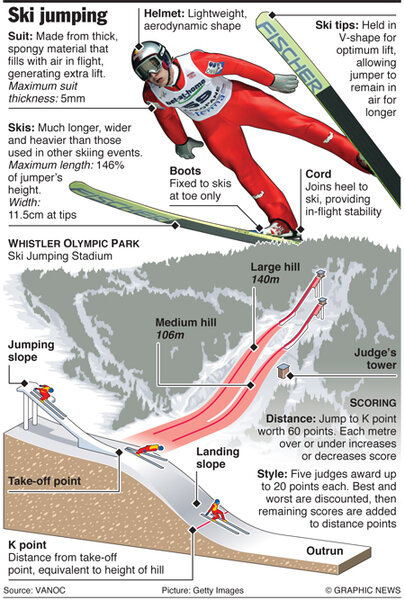Vancouver 2010 Olympic Games: Ski jumping
Loading...
Soaring above the rugged British Columbia landscape, the young Austrian sensation Gregor Schlierenzauer will aim for gold. But conspicuously absent will be women jumpers, who lost a legal battle to end Olympic ski jumping's 86-year history as a men's-only sport.
Who to Watch
Gregor Schlierenzauer, AUT (see video)
Schlierenzauer just turned 21, but he’s already celebrated more World Cup wins than birthdays. His work ethic is renowned in the ski jumping world, where he made a name for himself last year by capturing the overall World Cup title. Part of a dominant Austrian team, Schlierenzauer heads to Vancouver as one of the top-ranked jumpers in the world and a key contender for gold.
After the season, perhaps he’ll have more opportunity to indulge is some of his hobbies – cooking, photography, and poker. German speakers can check out his website for more personal details and photos.
Event Details
Click here for schedule and results.
In each of ski jumping’s three events, competitors are judged on distance, form, and landing. While a jumper's technique scores are important in their overall score, the skier with the longest distance generally earns the most style points (see how they train).
Each competition round is designed to allow the best jumpers to reach the point where the hill beings to level out, but no farther – if they were to land on the flatter part of the slope, it could result in serious injury. To avoid such outcomes, judges determine how far up the in-run the athletes should start – the higher the start, the greater the opportunity to gain velocity.
Judges standing along the landing hill visually determine the length of each jump in case the video equipment fails. But in the old days, there was no video system, and the competition results were decided by the naked eye.
-
Normal Hill Individual: Despite representing their countries at the Olympic Games, most of the athletes must first qualify to actually compete in the official competition. While the top 15 internationally ranked jumpers are prequalified to participate in the medal-contention rounds, only the top 35 skiers from the Olympic preliminary jumps may join them.
There are two rounds of jumps: the 35 top performing athletes from the first round advance to the second. In this final round, the best skiers jump last and lowest scoring skiers jump first
- Large Hill Individual: Just like the normal hill individual competition but held on the large hill.
- Team: Sixteen four-man teams compete in two rounds. During the first round, each of the four jumpers has one attempt. The top eight teams from the first round advance to the final round. The team with the highest total score between both rounds wins
History
Forget ski cross or the snowboard half-pipe. Ski jumping is the original extreme sport of the Winter Olympics. Accelerating from 0 to 60 m.p.h. as fast as a BMW, ski jumpers launch off the in-run and fly as far as two football fields placed end to end. Demanding explosive strength and technical precision, the graceful arc of the best jumpers belies the difficulty inherent in their sport.
For women, there’s an added obstacle: The International Olympic Committee turned down a 2006 bid to add women's jumping to the Olympic program, saying there wasn't enough depth at the top level. A group of female elite international ski jumpers took their case to the Canadian courts in an attempt to gain entrance to the 2010 Vancouver Games under a Canadian law that prohibits gender discrimination in government-sponsored activities.
Though the initial judge agreed that the IOC’s refusal to admit women, which lack the depth of the men’s field, constituted discrimination, but ruled that the Vancouver Organizing Committee was powerless to do anything about it. That ruling was upheld on appeal, and the Supreme Court refused to hear the case, ending the women’s bid to compete in Vancouver.
Sources: nbcolympics.com, vancouver2010.com, http://www.gregorschlierenzauer.at/gregor/






